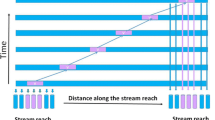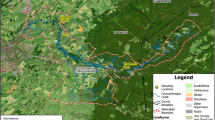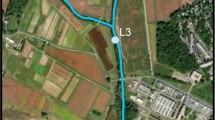Abstract
Fecal indicator bacteria (FIB) inhabiting stream sediments have become a concern with regard to recreational and irrigation water quality. Sediments contain higher concentrations of E. coli and other FIB than the overlying water column. The objective of this work was to evaluate the effect of temperature oscillations on the populations of both E. coli and enterococci in sediments and the water column. The study was conducted in a microcosm system with flow-through chambers representing a small stream with two different sediment textures. Bovine manure was freshly collected and mixed with both clayey and sandy sediment. Temperatures within the chambers oscillated from 17° to 28 °C which is representative of a diurnal summer temperature range for Maryland; the control chambers were kept at 22 °C. The effect of temperature oscillations differed depending on the sediment texture. Bacterial populations in the sandy sediment immediately increased before net die-off began. Conversely, in the chambers with the clayey sediments, there was no immediate increase in concentrations in the oscillation chambers as compared to the controls. There were significantly higher populations of both E. coli and enterococci within the oscillation sandy texture chambers compared to the control constant temperature chambers; that was not the case in the clayey sediment chambers. The die-off rates in the sandy sediments were greater than those in the clayey sediments; in the latter, bacteria populations remained almost constant throughout the experiment. Temperature oscillations should be simulated in experiments designed to estimate and compare inactivation rates for fecal indicator bacteria in sediments for future inferences on microbial water quality.



Similar content being viewed by others
References
Atwill, R., Lewis, D., Pereira, M., Huerta, M., Bond, R., Ogata, S., & Bass, P. (2007). Characterizing freshwater inflows and sediment reservoirs of fecal coliforms and E. coli at five estuaries in northern California. University of California School of Veterinary Medicine and Cooperative Extension in Sonoma and Marin Counties, Davis.
Chandran, A., Varghese, S., Kandeler, E., Thomas, A., Hatha, M., & Mazumder, A. (2011). An assessment of potential public health risk associated with the extended survival of indicator and pathogenic bacteria in freshwater lake sediments. International Journal of Hygiene and Environmental Health, 214, 258–264.
Cho, K. H., Pachepsky, Y. A., Kim, J. H., Guber, A. K., Shelton, D. R., & Rowland, R. (2010). Release of Escherichia coli from the bottom sediment in a first-order creek: Experiment and reach-specific modeling. Journal of Hydrology, 391(3–4), 322–332.
Cinotto, P. J. (2005). Occurrence of fecal-Indicator Bacteria and protocols for identification of fecal- contamination sources in selected reaches of the west branch Brandywine Creek, Chester County, Pennsylvania U. S. Department of the Interior. Director, 1–91.
Cools, D., Merckx, R., Vlassak, K., & Verhaegen, J. (2001). Survival of E. coli and Enterococcus spp. derived from pig slurry in soils of different texture. Applied Soil Ecology, 17(1), 53–62.
Craig, D. L., Fallowfield, H. J., & Cromar, N. J. (2004). Comparison of decay rates of faecal indicator organisms in recreational coastal water and sediment. Water Science and Technology: Water Supply, 2(3), 131–138.
Davies, C. M., Long, J. A. H., Donald, M., & Ashbolt, N. J. (1995). Survival of Fecal Microorganisms in Marine. American Society for Microbiology, 61(5), 1888–1896.
Dazzo, F., Smith, P., & Hubbell, D. (1973). The influence of manure slurry irrigation on the survival of fecal organisms in Scranton fine sand. Journal of Environmental Quality., 2(4), 470–473.
Desmarais, T. R., Solo-Gabriele, H. M., & Palmer, C. J. (2001). Influence of soil on fecal indicator organisms in a tidally influenced subtropical environment. Applied and Environmental Microbiology, 68(3), 1165–1172.
Garzio-Hadzick, A., Shelton, D. R., Hill, R. L., Pachepsky, Y. A., Guber, A. K., & Rowland, R. (2010). Survival of manure-borne E. coli in streambed sediment: Effects of temperature and sediment properties. Water Research, 44(9), 2753–2762.
Haller, L., Amedegnato, E., Poté, J., & Wildi, W. (2009). Influence of freshwater sediment characteristics on persistence of fecal Indicator Bacteria. Water, Air, and Soil Pollution, 203(1–4), 217–227.
Hammer, Ø., Harper, D. A. T., & Ryan, P. D. (2001). PAST: Paleontological statistics software package for education and data analysis. Palaeontologia Electronica, 4(1) 9pp.
Hartel, P. G., Rodgers, K., Fisher, J. A., Mcdonald, J. L., Gentit, L. C., Otero, E., … Jones, S. H. (2005). Survival and regrowth of fecal enterococci in desiccated and rewetted sediments. Environmental Technology, 2–5.
Ishii, S., Sadowsky, M. J., Yan, T., Hansen, D. L., Hicks, R. E., & Vu, H. (2010). Factors controlling Long-term survival and growth of naturalized Escherichia coli populations in temperate field soils. Microbes and Environments, 25(1), 8–14.
Kiefer, L. A., Shelton, D. R., Pachepsky, Y., Blaustein, R., & Santin-Duran, M. (2012). Persistence of Escherichia coli introduced into streambed sediments with goose, deer and bovine animal waste. Letters in Applied Microbiology, 55, 345–353.
Lee, C. M., Lin, T. Y., Lin, C. C., Kohbodi, G. N. A., Bhatt, A., Lee, R., & Jay, J. A. (2006). Persistence of fecal indicator bacteria in Santa Monica Bay beach sediments. Water Research, 40(14), 2593–2602.
Mallmann, W. L., & Warren Litsky, M. S. (1951). Survival of selected enteric organisms in various types of soil. American Journal of Public Health., 41, 38–44.
Niewolak, S. (1998). Total viable count and concentration of enteric bacteria in bottom sediments from the Czarna Hańcza River , Northeast Poland. Polish Journal of Environmental Studies, 7(5), 295–306.
Oliveira, M., Viñas, I., Usall, J., Anguera, M., & Abadias, M. (2012). Presence and survival of Escherichia coli O157:H7 on lettuce leaves and in soil treated with contaminated compost and irrigation water. International Journal of Food Microbiology, 156, 133–140.
Pachepsky, Y. A., & Shelton, D. R. (2011). Escherichia coli and fecal coliforms in freshwater and estuarine sediments. Critical Reviews in Environmental Science and Technology, 41(12), 1067–1110.
Pachepsky, Y. A., Stocker, M. D., Saldaña, M. O., & Shelton, D. R. (2017). Enrichment of stream water with fecal indicator organisms during baseflow periodds. Environmental Monitoring and Assessment., 189, 51.
Perkins, T. L., Clements, K., Baas, J. H., Jago, C. F., Jones, D. L., Malham, S. K., & McDonald, J. E. (2014). Sediment composition influences spatial variation in the abundance of human pathogen indicator bacteria within an estuarine environment. PLoS One, 9(11).
Poté, J., Haller, L., Kottelat, R., Sastre, V., Arpagaus, P., & Wildi, W. (2009). Persistence and growth of Faecal Culturable bacterial indicators in water column and sediments of Vidy Bay, Lake Geneva, Switzerland. Journal of Environmental Sciences, 21, 62–69.
Powers, J. J., Lukaszewicz, W., Wheeler, R., & Dornseifer, T. P. (1965). Chemical and microbial activity rates under square-wave and sinusoidal temperature fluctuations. Journal of Food Science, 30(3), 520–530.
Rajkowski, K. T., & Marmer, B. S. (1995). Growth of Escherichia coli O157:H7 at fluctuating incubation temperatures. Journal of Food Protection, 58(12), 1307–1313.
Semenov, A. V., Van Bruggen, A. H. C., Van Overbeek, L., Termorshuizen, A. J., & Semenov, A. M. (2007). Influence of temperature fluctuations on Escherichia coli O157:H7 and Salmonella enterica serovar typhimurium in cow manure. FEMS Microbiology Ecology, 60(3), 419–428.
Soupir, M. L., Mostaghimi, S., & Lou, J. (2008). Die-off of E. coli and enterococci in dairy cowpats. Transactions of the ASABE, 51(6), 1987–1996.
Stocker, M.D., M. Penrose & Y. A. Pachepsky. (2018). Spatial Patterns of Concentrations in Sediment before and after High-Flow Events in a First-Order Creek. Journal of Environment Quality. 47 (5):958.
Thelin, R., & Gifford, G. F. (1983). Fecal coliform release patterns from fecal material of cattle. Journal of Environment Quality, 12(1), 57–63.
USEPA. 2012. Recreational water quality criteria. USEPA, Washington, DC.
Van Kessel, J. S., Pachepsky, Y. A., Shelton, D. R., & Karns, J. S. (2007). Survival of Escherichia coli in cowpats in pasture and in laboratory conditions. Journal of Applied Microbiology, 103(4), 1122–1127.
Wade, T. J., Pai, N., Eisenberg, J. N. S., & Colford, J. M. (2003). Do U.S. Environmental Protection Agency water quality guidelines for recreational waters prevent gastrointestinal illness? A systematic review and meta-analysis. Environmental Health Perspectives, 111(8), 1102–1109.
Walters, E., Kätzl, K., Schwarzwälder, K., Müller, E., Rutschmann, P., & Horn, H. (2014). Persistence of fecal indicator bacteria in sediment of an oligotrophic river: Comparing large and lab-scale flume systems. Water Research, 61, 276–287.
Wang, D., Dunfield, K., Wu, F., Warriner, K., Murray, K., & Huber, A. (2018). Comparative persistence of Salmonella and Escherichia coli O157:H7 in loam or sandy loam soil amended with bovine or swine manure. Canadian Journal of Microbiology, 64(12), 979–991.
Zhai, Q., Coyne, M. S., & Barnhisel, R. I. (1995). Mortality rates of fecal Bacteria in subsoil amended with poultry manure. Bioresource Technology, 54(1995), 165–169.
Author information
Authors and Affiliations
Corresponding author
Additional information
Publisher’s Note
Springer Nature remains neutral with regard to jurisdictional claims in published maps and institutional affiliations.
Electronic supplementary material
ESM 1
(DOCX 377 kb)
Rights and permissions
About this article
Cite this article
Smith, J.E., Stocker, M.D., Hill, R.L. et al. The Effect of Temperature Oscillations and Sediment Texture on Fecal Indicator Bacteria Survival in Sediments. Water Air Soil Pollut 230, 270 (2019). https://doi.org/10.1007/s11270-019-4278-7
Received:
Accepted:
Published:
DOI: https://doi.org/10.1007/s11270-019-4278-7




